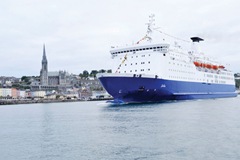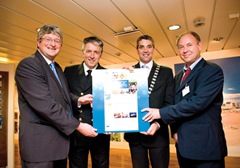A rising tide: reinstallment of the Cork-Swansea ferry
 Stephen Dineen reports on the Cork-Swansea ferry service which was restored in 2010 through the determination of the local people.
Stephen Dineen reports on the Cork-Swansea ferry service which was restored in 2010 through the determination of the local people.
There has been much discussion in recent times of tourism’s role in Ireland’s economic future, but for the people of west Cork and Kerry tourism has always been part of economic life. When the Cork-Swansea ferry service closed in 2006, causing significant loss of tourism to the region, a people power was unleashed that could have launched a thousand ships. Not only did they get a ferry service restored but they took ownership of it too.
In 2006 the Cork-Swansea ferry service, which had operated since 1987, closed. Over the years it had facilitated the visit of countless tourists to the south-west region. Local businesses, in west Cork and Kerry in particular, felt the effects of losing the service. It was reported by sources in the tourist industry that there was a 30 per cent drop in the number visiting the region.
Initial attempts to revive the route failed. Efforts in 2007 and 2008 saw the representatives of the Port of Cork, the Associated British Ports (the company responsible for Swansea Port) and businesses working together to try to get a new operator and ship. A business plan was drafted by interested parties and several countries were visited to identify suitable ships. Several Irish businesses became interested in purchasing one particular vessel but it was purchased by a Russian ferry company.
In early 2008 a conversation between John Hosford, the owner of a garden centre in west Cork, and a stained glass window artist, Adrian Brentnall, led to a publicity campaign to get the ferry back. “I always felt that our nearest market was the British market,” Hosford tells eolas, “and I felt that without proper access you can’t have a proper tourism market.” With so many people having travelled back and forth every year Hosford “felt something had to be done about it and it had to be highlighted in the media and so on.”
They set up a website with an online petition, which received over four thousand signatories “from all over the world, from as far away as Chile, Australia, Britain, people from the continent who would use it as a land-bridge across Britain as well,” claims Hosford. The campaign gained momentum when media outlets such as the BBC and ITV highlighted their campaign. Hosford and his group put a petition in the Welsh Assembly and then two years ago was invited to address a committee of the legislature.
In 2009 it emerged that a small group of Cork-based investors were willing to provide a significant amount of capital to buy a particular vessel, but further equity would be needed. The ferry was the vessel a Russian company had succeeded in buying ahead of Irish businesses in 2008. Conor Buckley was chairman of West Cork Tourism, a lobbying group, at the time. “It became apparent to us as a group that there wasn’t anybody out there who was prepared to put [the balance of] capital on the table for the project,” he tells eolas. “One night over a cup of coffee I asked four members of the group: ‘Should we not go to the industry locally and ask them would they be interested in putting up the capital?’ and that’s what we did. So over the course of four or five weeks we either pledged or raised €2.5 million.”
Buckley and others “went around on a local level to town halls, hotels, parish halls etc. and dropped people in, made the case for the economic viability of the region and re-establishing the route, and asked people to consider effectively investing in their own businesses by restoring the access,” he says. The money was secured through pledges of €10,000 from individuals or syndicates of the same amount. Local media highlighted the campaign. Some of the money was raised by activists knocking on doors.
 When the business investors withdrew from the plan it didn’t deter Buckley who, along with Paul O’Brien, led the campaign and proposed that the local people take full ownership of the venture. On 7 April 2009 the co-op shareholders voted to form the West Cork Tourism Cooperative and sanctioned a board to negotiate with a Finnish bank to purchase the ferry. The Finnish bank, which owned the ship following the bankruptcy of the previous owners, loaned the co-op 60 per cent of the start-up costs (the ship cost €7.8 million). The Fastnet Line, the brand under which the ship operates, has also been assisted financially by the councils in Cork and Kerry, Fáilte Ireland, as well as subsidies from the Port of Cork and the Associated British Ports.
When the business investors withdrew from the plan it didn’t deter Buckley who, along with Paul O’Brien, led the campaign and proposed that the local people take full ownership of the venture. On 7 April 2009 the co-op shareholders voted to form the West Cork Tourism Cooperative and sanctioned a board to negotiate with a Finnish bank to purchase the ferry. The Finnish bank, which owned the ship following the bankruptcy of the previous owners, loaned the co-op 60 per cent of the start-up costs (the ship cost €7.8 million). The Fastnet Line, the brand under which the ship operates, has also been assisted financially by the councils in Cork and Kerry, Fáilte Ireland, as well as subsidies from the Port of Cork and the Associated British Ports.
Timing was not on the co-op’s side for getting the ferry sailing for the summer of 2009 but the Julia had its first sailing from Cork to Swansea on 10 March 2010. In a remarkable coincidence, the month after the service started Ireland’s airspace was highly disrupted for nearly three weeks because of volcanic ash cloud. Buckley, who is now chairman of the Fastnet line, says that though it didn’t make a big financial difference, “it certainly gave it [the ferry] a huge boost in terms of profile.”
The businesses of the region have noticed an increase in tourist traffic since the ferry returned. “The occupancy went up,” says Hosford of hotels and guest houses in 2010. Buckley says that “[I]f you’re in any town or village at this time of year you’ll see the yellow registration number plates passing you on the road.” Providers of activities that require heavy equipment such as sea kayaking or cycling say they have noticed a considerable difference.
The first twelve months saw the ferry meet its target of 78,000 passengers (the ferry was in dry docking for seven weeks earlier this year to reduce costs). This year the target is 85,000, and Buckley is optimistic
it will be met. “The challenge is around fuel prices, which are 30 to 40 per cent up on the same time last year,” he says. “But in terms of the numbers we’re happy with it. Numbers are up slightly on last year, passengers appear to be very happy with us and freight numbers have been up substantially over last year,” explains Buckley, who won Cork Person of the Year in 2009 for his work in reviving the Cork- Swansea ferry.
The people of the region remain enthusiastic about the project. “You’re maintaining jobs whereas a new industrial start-up may never occur or rarely occurs on some of the furthest peninsulas in west Cork or Kerry,” says Hosford. He says the artisan food producers and arts and crafts makers all rely on the tourism. “If you’ve a vibrant tourist industry it percolates down the line to them as well.”
In another coincidence in the story of ‘the people’s ferry’, as it is called, newly promoted Swansea FC is the first non-English team to play in the Premier League since its inception. Fastnet is actively looking at changing the schedule to facilitate the Premier League, but Buckley believes “it’s bound to be a positive development.”
While the future is uncertain for many in these difficult economic times it’s clear that no effort will be spared by those behind ‘the people’s ferry’, who have worked so hard to keep it afloat.
] ]>




